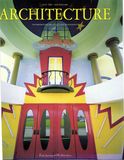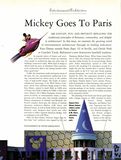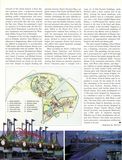


Are fantasy, fun, and frivolity replacing the traditional principles of firmness, commodity, and delight in architecture? In this issue, we examine the growing trend of entertainment architecture through its leading indicators: Euro Disney outside Paris, Expo '92 in Seville, and Oriole Park at Camden Yards, Baltimore's new downtown baseball stadium.
As popular places of leisure and recreation, such entertainment venues are expo more people to architecture than any other type of buildings constructed today. What kind of design is offered with the price of admission? Does entertainment architecture deliver any lasting benefits other than a good time?
Unlike the amusement parks and sports arenas of the past, the new entertainment architecture is being commissioned by clients savvy to the market value of high-profile design. The leader of today's enlightened patronage is the Walt Disney Company, whose most ambitious design project to date, Euro Disney, opened in April. Built on 4,800 acres of former beet fields in Marne-la-Vall6e, a Paris new town, Disney's $4.4 billion European venture comprises six hotels, an entertainment center, a campground, and a theme park. Like recently completed Disney commissions in Orlando and Burbank, the French complex showcases the talents of leading American architects – Robert A.M. Stern and Michael Graves, as well as Frank Gehry and Antoine Predock – who designed their hotels and other structures to reflect regional American themes, with an emphasis on the wild West.
Plans for Euro Disney, however, began long before these "star" architects were tapped by CEO and Chairman Michael Eisner. When Eisner joined Disney in 1984, the company had already been evaluating sites within Europe for its second foreign theme park. Tokyo Disneyland, opened in 1983, had proved a hit, breaking U.S. attendance records for a single day just four months'after it opened. Disney theme parks in the U.S. were also clearly popular among Europeans, and with the removal of trade barriers by 1992, the corporation decided to move full-steam ahead, narrowing its choices to France and Spain. Despite Spain's warm climate, France, with its proximity to other European cities, proved a better location, and the country offered Disney an enticing package of tax breaks, construction loans, major road expansions, and a $150 million extension of its commuter rail line.
The planning of the hotels and theme park began with a design charette in 1988, attended by Stern Graves, Gehry, Stanley Tigerman, and Robert Venturi. Tigerman and Venturi were ultimatelv ruled out, Predock brought in, and French architect Antoine Grumbach chosen as the sole European architect. The outcome of the initial charette is Euro Disney's greatest asset: a pedestrian-oriented plan that links hotels and theme parks with parking, public transportation, and entertainment facilities. The hotels are arranged around a man-made lake and river, and for the first time, Disney has positioned a hotel as a gateway to its theme park, the Neo-Victorian Hotel Disneyland, conceived by Disney's Imagineers and implemented by Wimberly Allison Tong & Goo of Honolulu.
Compared to the recently completed projects in Orlando, however, Euro Disney's architecture is disappointing. Most of the hotels are inflated in proportions to accommodate 1,000 rooms, and their separate themes coexist uncomfortably with one another. The luxury hotels by seasoned Mouseketeers Robert Stern, who was recently appointed to Disney's board of trustees, and Michael Graves, architect of Disney's Burbank headquarters and Orlando hotels, are clearly not the architects' best. Despite its elegant detailing and gracious interiors, Stern's Newport Bay, a gigantic version of his Yacht and Beach Club in Orlando, is too overblown for its prominent location, dominating the main vehicular entrance with its colonnaded bulk. Graves's hotel draws upon his familiar Italianate vocabulary and saturated color palette, but lacks the decorative flamboyance of the Swan and Dolphin. Billed as the Hotel New York, its stripped-down volumes have nothing to do with the skyscrapers and brownstones of Manhattan. Antoine Grumbach's Hotel Sequoia, themed to convey rustic mountain lodges and expansive Prairie Style houses, also suffers from mixed regionalist messages and hulking proportions.
More successful are Stern's cowboys-and-Indians Hotel Cheyenne and Predock's pueblolike Hotel Santa Fe, miniature towns of discrete buildings linked by squares and streets. Both borrow from Western films, treating their themes as cinematic sequences. Stern's Cheyenne plays it straight with a stage set of false-fronted buildings, while Predock takes a more cynical view of the West, dotting his sparse landscape with quirky artifacts such as a meteorite, junked cars, and a UFO. Stern's playful Espace Euro Disney, a 33,000-square-foot visitors center located to the west of the hotel and theme park complex, is also successful. Topped by a conical roof – an architectural rendering of the sorcerer's hat Mickey wore in Fantasia – painted with silhouettes of Disney characters, its brightly colored exterior offers the autoroute an appropriately animated billboard for the hotels and theme park.
The most original building at Euro Disney isn't a hotel, but Frank Gehry's Fesdval Disney, a shopping, restaurant, and entertainment center. The sprawling, low-rise ensemble is punctuated by a grid of 66-foot-high striped columns that march among the architect's signature sculptural sheds. Various themes of the restaurants and stores – 1950s diner, wild West rodeo theater, surf shop – are confined to exterior signage and building interiors. At dusk, Gehry's bold, steel-clad columns glow with reflected light from neon signs and support a lacy canopy of lights, creating a glittering, nighttime circus for adults.
In the future, Festival Disney may be expanded to occupy the last empty lot on the lake, depending on the success of the current theme park facilities. Already, Disney is marching ahead with further plans for its French outpost. Now under development is a 2,700-room hotel designed by Architectonica, scheduled to open in 1995; a corporate headquarters designed by Aldo Rossi; a golf club, 700-room hotel, and convention center by Gwathmey Siegel & Associates; an exclusive enclave of custom houses designed by Gwathmey Siegel, Charles Moore, Hugh Newell Jacobsen, and Jacquelin Robertson; and 5,4O0 units of employee housing. Whether any of these developments will surpass Euro Disney's first phase and produce more provocative, contemporary architecture remains to be seen.